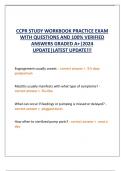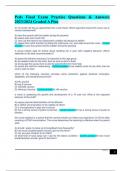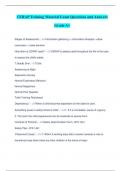CCPR STUDY WORKBOOK PRACTICE EXAM
WITH QUESTIONS AND 100% VERIFIED
ANSWERS GRADED A+|2024
UPDATE|LATEST UPDATE!!!
Engorgement usually onsets: - correct answer > 3-5 days
postpartum
Mastitis usually manifests with what type of symptoms? -
correct answer > Flu-like
What can occur if feedings or pumping is missed or delayed? -
correct answer > plugged ducts
How often to sterilized pump parts? - correct answer > once a
day
,At the end of the second postpartum week, the target daily
milk volume should be: - correct answer > 800-1000 mL
In which situations is breast feeding permissible or not
recommended? HIV, Hep B, CMV, Hep C - correct answer >
HIV: not recommended, Hep BP: permissible, CMV:
permissible, Hep C: permissible
Total body water: - correct answer > intracellular fluid +
extracellular fluid
Term infants lose how much weight as a result of loss of TBW? -
correct answer > 5-10% BW
Preterm infants lose up to ____% as a result of loss of TBW? -
correct answer > 15%
At lower gestation age, extracellular fluid accounts for
________ proportion of birthweight. - correct answer >
greater
When is greater weight loss at birth beneficial? - correct
answer > CLD & PDA
,Sources of water loss in preterm infants: - correct answer >
renal loss (increases with decreased GA), IWL (increase temp,
skin breakdown, radiant warmers, phototherapy, ELBW), stool
loss, CSF drainage, NGT/thoracostomy drainage
Effects of insensible water loss in very low birth weight infants:
- correct answer > weight loss, decreased skin turgor, sunken
fontanelle, dry mucous membranes, tachycardia, delayed cap
refill, hypotension
Predisposing factors to dehydration: - correct answer > loss of
na & H20 (nasogastric drainage), third spacing, renal losses
S/S of dehydration: - correct answer > weight loss, decreased
UO (if <32 weeks, may not have oliguria), increased urine SG,
poor skin turgor, tachycardia, hypotension, metabolic
acidosis, increased BUN
Hyponatremia due to ECF volume depletion: - correct answer >
diuretic use, osmotic diuresis (glucosuria), VLBW with renal
H2O and Na wasting, GI losses, third spacing
, Hyponatremia with normal ECF volume: - correct answer >
increased fluid administration, SIADH
Hyponatremia with excess ECF: - correct answer > sepsis with
decreased CO, late NEC, heart failure, abnormal lymphatic
drainage, neuromuscular paralysis
Fluid challenge in managing oliguria: - correct answer > Bolus
of 10mL/kg NS administered in 2 infusions at 10mL/hr if no
structural heart disease or heart failure exists. Augments GFR
& UO.
Prerenal causes of oliguria: - correct answer > decreased
preload, increased peripheral resistance
Parenchymal causes of oliguria: - correct answer > DIC, actuate
tubular necrosis
Postrenal causes of oliguria: - correct answer > posterior
urethral valves, uric acid nephropathy
Causes of metabolic acidosis with anion gap >15: - correct
answer > inborn errors of metabolism, acute renal failure






